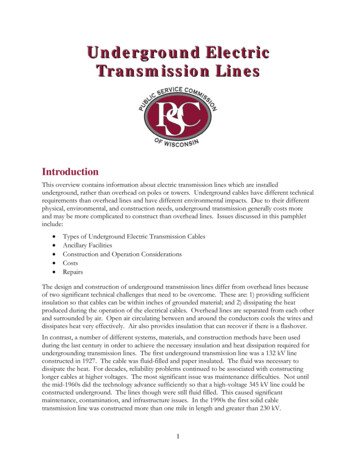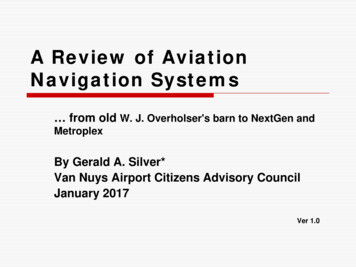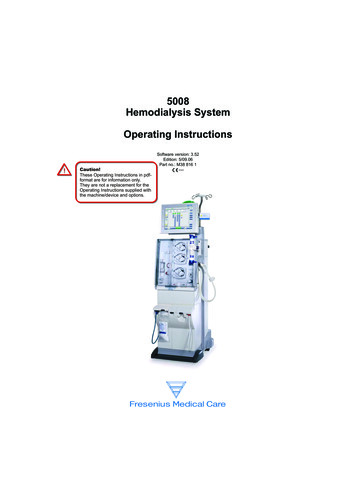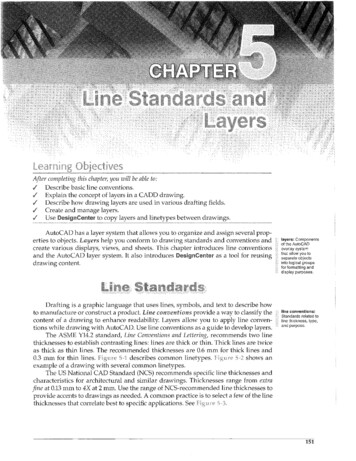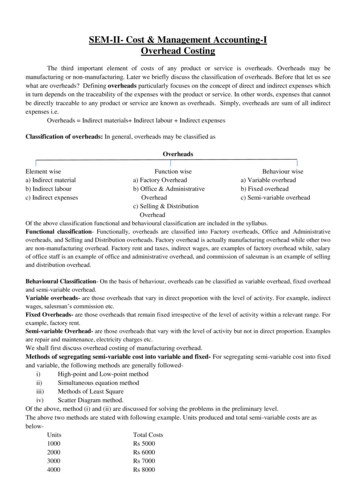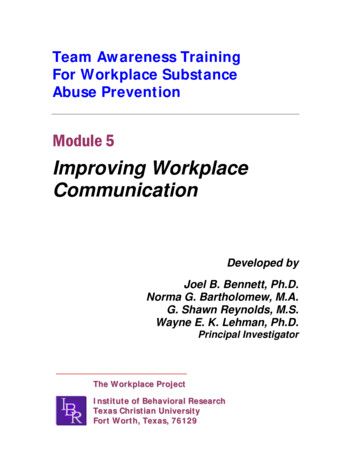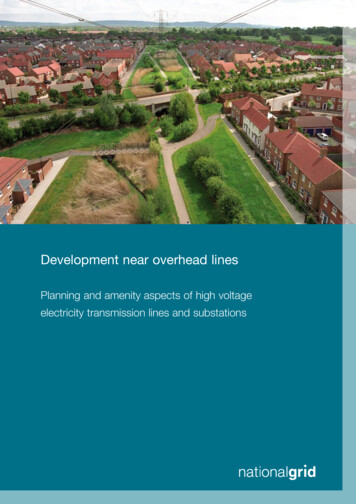
Transcription
Development near overhead linesPlanning and amenity aspects of high voltageelectricity transmission lines and substations
ContentsWho we are and what we do3Overhead lines and substations5Consent procedures6Amenity responsibilities7Schedule 9 StatementEnvironmental Impact AssessmentRouteing of overhead lines789Siting of substations10Development near overhead lines and substations11Safety aspectsMaintenanceVisual impactNoiseElectric and magnetic fieldsOther electrical effects121213141516Development plan policy18Appendix I19Glossary19Appendix IIMain features of a transmission lineAppendix IIISafety clearancesContacts and further information2121232327This document provides information for planning authorities and developers on NationalGrid’s electricity transmission lines and substations. It covers planning and amenityissues, both with regard to National Grid’s approach to siting new equipment, and todevelopment proposals near overhead lines and substations.2
Who we are and what we doElectricity is generated at power stationsaround the country. These power stationsuse a variety of fuels - principally coal,gas, oil, nuclear and wind - to generateelectricity, and the stations are generallysited to be close to fuel and cooling waterrather than to be near centres of demand.National Grid’s electricitytransmission network.Electricity is then transmitted fromthe power stations through a nationalnetwork of electricity lines which operateat high voltage. National Grid owns theelectricity transmission network in Englandand Wales and operates the electricitytransmission system throughout GreatBritain. Local distribution companies thensupply electricity at progressively lowervoltages to homes and businesses.This transmission system which operatesat 400,000 and 275,000 volts (400kVand 275kV) is known as the “nationalgrid” and covers some 4,500 route milesof overhead line, 420 route miles ofunderground cable and more than 335substations. The system, which connectsthe electricity generators’ power stationswith the networks of the local distributioncompanies, also connects with somelarge industrial customers who, by reasonof their size and technical characteristicsor location, are directly connected to thetransmission system.Under the Electricity Act 1989 NationalGrid is the holder of a transmissionlicence. It is required in this capacityto develop and maintain an efficient,coordinated and economical system ofelectricity transmission and to facilitatecompetition in the supply and generationof electricity.3
Unlike virtually all other commodities,electricity cannot be stored in bulk until itis needed; it has to be generated in theright quantities, at the time it is needed.The vast majority of generating capacityin England and Wales is connected byNational Grid’s transmission system. Thisenables the operation of power stationsto be coordinated, offering potentialbenefits of reducing the amount of sparegenerating capacity and generatingreserve needed, and the ability to selectpower generation to supply the needs ofthe moment.The energy industry is currentlygoing through a period of significantchange resulting in a multi-billionpound investment programme. Thiswill encompass small and large scaleelectricity generation and substantialinvestment in energy networks to replaceand upgrade ageing assets, construct newinfrastructure to connect and efficientlydeliver new energy sources, as wellas maintaining the levels of safety andreliability to which everyone has becomeaccustomed.4This note describes National Grid’samenity responsibilities. It briefly sets outboth the amenity aspects which NationalGrid takes into account in siting newelectricity lines and substations, and theamenity aspects which are relevant toproposed development near NationalGrid’s electricity transmission equipment.The note goes on to explain theseconsiderations in more detail, which webelieve developers and local planningauthorities may wish to take into account.
Overhead lines and substationsAn electricity line consists of either anoverhead line or an underground cable, orboth. A typical National Grid overhead lineroute uses three main types of lattice steeltower (or pylon). These are: suspension towers which support theconductors on straight stretches of line; deviation towers at points where theroute changes direction; and terminal towers where lines terminateat substations or are connected tounderground cables.Appendix II illustrates these features.National Grid’s substations are necessaryfor the efficient operation of thetransmission system, for the specificrole of switching circuits or transformingvoltage. They are normally sited betweenpower stations and the transmissionnetwork, and between the transmissionnetwork and the local distributioncompanies’ networks. They can besizeable developments, and includingconnecting terminal towers, can occupyup to 20 hectares.However, advances in technology meansthat the equipment located at substationsis now more compact than that of the1950s and 1960s when many of theexisting substations were built. Hencenew substations are considerably smallerin size, both in height and area covered,and in certain circumstances, can besited inside a building which resemblesan industrial unit. Substations are usuallycontained within steel palisade fencing toensure public safety, and the structures,excluding towers, are not usually morethan 15m in height. Road access isnecessary for staff, and for the transportof equipment during construction,maintenance or repair. Very occasionally,transformers or other very large items ofplant may need to be moved into or out ofsites as abnormal indivisible loads.5
Consent proceduresNational Grid is a statutory undertakerunder the Town and Country Planning(General Permitted Development)Order 1995. The Order grants planningpermission for certain defined classes ofdevelopment. National Grid therefore hascertain rights to carry out developmentunder the Order without the need forplanning permission from the localplanning authority. This permitteddevelopment relates primarily todevelopment in existing substations, onoperational land and to undergroundcables. New substations or majorextensions to existing substations mayrequire planning permission from localplanning authorities.To construct a new overhead line ineither England or Wales, National Gridrequires formal consent, under section37 of the Electricity Act 1989, from theSecretary of State for Business, Enterpriseand Regulatory Reform, unless the newline is across land owned and occupiedby the company. The Electricity Act1989 contains a formal procedure forconsultation with local planning authoritieswithin whose areas the new line isproposed. If they maintain an objectionto an application for section 37 consentthen the Secretary of State is required toconvene a public inquiry. When grantingsection 37 consent, the Secretary of Statewill usually direct that planning permissionfor the development will be deemed tobe granted under the Town and CountryPlanning Act 1990.6Advice on the procedure for consultinglocal planning authorities is given ina Circular issued jointly by the thenDepartment of the Environment (Circular14/90 of that office) and the then WelshOffice (Circular 20/90).Under its duty in the Electricity Act 1989to facilitate competition in the supply andgeneration of electricity, National Grid mustoffer connection facilities to any new orproposed power station or plant, includingoffering connections to a local distributioncompany or major industry that requiresa high voltage electricity supply. Thereforeproposals for a new electricity generationproject may also involve transmissionworks away from the power station site,such as new overhead lines, modificationsto existing lines or new development atsubstations. These transmission worksmay be the responsibility of NationalGrid, the distribution companies or thegenerator itself depending upon theparticular circumstances of each case.A generator promoting a new powerstation of over 50 megawatts generationcapacity would seek consent undersection 36 of the Electricity Act 1989.Although such an application would beseparate from any associated transmissionworks, discussions between the generatorand National Grid normally take placeat an early stage. Indeed, National Gridwould encourage prospective generatorsto consult it in advance of the consentprocess so that transmission and consentimplications of the project can be fullyconsidered.
Amenity responsibilitiesSchedule 9 StatementUnder section 38 of the ElectricityAct 1989, National Grid has a dutyin formulating proposals for newdevelopment to “have regard to thedesirability of preserving natural beauty,of conserving flora, fauna and geologicalor physiographical features of specialinterest and of protecting sites, buildingsand objects of architectural, historic orarchaeological interest; and shall do what[it] reasonably can to mitigate any effectwhich the proposals would have on thenatural beauty of the countryside or onany such flora, fauna, features, sites,buildings or objects.”National Grid is also required underschedule 9 of the Act to produce andpublish a statement setting out how itproposes to meet this obligation. Thecompany’s Schedule 9 Statement isavailable as a separate elopment/SC/Responsibilities/Schedule 9National Grid Electricity Transmission plcElectricity Act 1989 – Schedule 9 StatementDuty of Preservation of Amenity7
Environmental Impact AssessmentOverhead lines with a voltage of 220kVor more and a length of more than 15kmwhich require consent under section 37of the Electricity Act 1989 are includedin schedule 1 of The Electricity Works(Environmental Impact Assessment)(England and Wales) Regulations 2000 (asamended). These regulations implementEuropean Directive 85/337/EEC asamended by Directive 91/11/EC whichset out procedures for the assessmentof the effects of certain projects on theenvironment. For all development listedin schedule 1 of the regulations, thepreparation of an environmental statementis mandatory. As such National Gridwill always undertake an environmentalimpact assessment of all new high voltageoverhead line routes of more than 15kmin length and submit an environmentalstatement.8A separate list of developments is coveredin schedule 2 of the regulations. Aschedule 2 development project need onlybe subject to environmental assessmentif it is likely to have a significant effecton the environment because of its size,nature or location. The regulations statethat where proposals include a highvoltage overhead line or an overhead lineinstalled in a sensitive area, the need foran environmental impact assessmentwill be determined on a case-by-casebasis. National Grid will therefore carryout environmental impact assessmentsfor some overhead line developmentswhich fall into schedule 2, dependenton consultation with the relevant localplanning authorities and the outcome ofthe screening process.Environmental statements are not requiredunder the legislation for new substationproposals, however National Grid hasgiven a commitment in its’ Schedule9 Statement to undertake relevantenvironmental investigations and reporton these in any application for consent fornew works.
Routeing of overhead linesGuidelines for the routeing of newoverhead lines were originally formulatedby the Central Electricity Generating Board(CEGB), a predecessor to National Grid.These guidelines have subsequently beenreviewed and supplemented by NationalGrid and are used as the basis of thecompany’s approach to routeing newoverhead lines.The guidelines set out the principles to beapplied in the routeing of new overheadlines. They cannot be expected to coverevery possible situation and each casemust be considered separately and on itsown merits.The selection of any new electricity lineroute will be a balance of all the variousfactors or constraints which have to betaken into account. Any overhead line willbe a visual intrusion into the landscapethrough which it passes, and it is thedominant scale of towers which makesthem difficult to absorb into the landscape.In selecting a route National Grid seeks toreduce the visual effect of the line in termsof the number of people affected and thedegree to which they are affected. Thenature and topography of the landscapeis considered and any statutory protectionafforded to an area is also taken intoaccount.The selected route will typically seek toavoid crossing the highest contours,where towers would generally be themost prominent and will take accountof the quality of the landscape and itsability to accommodate an overhead line.In other words an overhead line should‘fit’ into the landscape as much as thatlandscape permits. The extent to whichopportunities exist to screen the line willdepend on existing vegetation, buildingsand topographic features. When viewedfrom principal viewpoints, an overheadline should ideally be viewed against abackground of existing landscape or otherdevelopment rather than against the sky.There may be a number of potentialconflicts of interest in establishing anew overhead line route. Sometimes,for example, the best route through alandscape will be to follow a river valleyrather than to cross the adjacent higherland. The valley, however, is likely to bemore intensively populated and alsomay contain the major transport routesin the area as well as the better qualityagricultural land. A new line so routedcould have a greater effect on a largernumber of people even though its effectoutside the valley may be minimal.Conversely for example, upland areas,whilst having relatively little development,are likely to have protective designationsand an overhead line across such areasmay be visible over a much wider area.These are all general routeing principles.In practice, the selection of a route willvery much depend on the circumstancesapplicable to each case.9
Siting of substationsThe general location of a substationis initially determined by transmissionrequirements and line routeing. Thesubstation may be required to increasethe supply of electricity from a powerstation into the national grid system fortransmission; or near an urban area, itmay be required as a grid supply point toreduce the voltage to lower levels for thelocal distribution companies. Its generallocation is defined by these factors.With regard to the precise location of asubstation, National Grid has guidelines toassist in siting and designing substationsto mitigate their environmental effects. Thesubstation guidelines complement NationalGrid’s line routeing guidelines and, whereappropriate, are used in conjunction withthem.Proposals for new or significantextensions to substations, do not requireenvironmental impact assessmentunder Government regulations oradvice. However, National Grid normallyundertakes relevant environmentalinvestigations on such proposals, andwould report on these investigations insubmitting any planning application to thelocal planning authority.This image shows an aerial view of St. John’s Wood400kV substation in north London. Amongst otherfactors, design of this GIS (gas insulated switchgear)substation had to take into account land constraintsin this urban area.10
Development near overhead linesand substationsNational Grid owns the land occupiedby its substations, but only exceptionallydoes it own the land which is crossed byits electricity lines. The line is retained bymeans of either wayleave agreements orpermanent easements with the landowner.National Grid has the power to maintainand renew the electricity line and to gainaccess for these purposes.National Grid seeks voluntary agreementswith landowners. However, when theseare not forthcoming National Grid hascompulsory powers and can apply tothe Secretary of State for a ‘necessarywayleave’ for the overhead line route, orcompulsory purchase of the land occupiedby the cable route. In such cases ahearing will take place which provides theopportunity for all issues to be discussed.Since it does not own the land, it cannotprevent development close to or underoverhead lines (although, of course, safeelectrical clearances must be maintained).It has sometimes been suggested thatminimum distances between propertiesand overhead lines should be prescribed.National Grid does not consider thisappropriate since each instance must bedealt with on its merits. However, it hasalways sought to route new lines awayfrom residential property on grounds ofgeneral amenity. Since the only limitationon new development has been thestatutory safety clearances (AppendixIII), a large amount of residential andother development has been carried outsubsequently beneath and adjacent tooverhead lines.Where development takes place and howit is designed are principally matters forthe landowner, developer and the localplanning authority to determine. NationalGrid should be consulted at an early stageon proposals for development near linesand substations, when it is more likely thatNational Grid’s advice and guidance ondevelopment near to electricity lines issuescan be taken into account.National Grid believes that the amenityconsiderations which are applied inrouteing overhead lines and sitingsubstations, should be considered inrespect of development proposed in thevicinity of overhead lines and substations.Such amenity and other considerationsare set out below. In addition NationalGrid has published comprehensive sitelayout, design and landscaping guidelinesto provide advice and pragmatic solutionsfor anyone involved in the planning,design and development of sites near highvoltage overhead electricity lines.Visit the Sense of Place website at:www.nationalgrid.com/uk/senseofplace11
Safety aspectsContact by people or objects with highvoltage equipment must be avoided. Atsubstations the high voltage compound isprotected by the provision of high securityfencing and all of National Grid’s towershave anti-climbing guards. For overheadlines a statutory minimum safety clearancemust be maintained between conductorsand the ground: the higher the voltage ofthe line, the greater the clearance which isrequired. Appendix III gives information onstatutory safety clearances and on wherefurther information and advice can beobtained.Safe clearances must be maintained frombuildings constructed under or adjacent tooverhead lines. Safe clearances must alsobe maintained for trees, structures suchas street lighting, new roads, and groundlevels where these will be altered by civilengineering operations.12Underground cables give rise to particularsafety requirements. Requirementsare dependent upon cable installationmethods but generally the area abovecables, and a distance on either side,must be kept clear of structures and trees.Access is required for maintenance andrepair. It is essential that the cables andmaterial surrounding them should not bedisturbed. Further information on cables isavailable on our website.MaintenanceFrom time to time access is requiredonto land to inspect, maintain andrefurbish overhead lines and undergroundcables. National Grid’s rights of accessto undertake such works are containedwithin the wayleave agreement orpermanent easement with the landowner.Overhead lines are inspected on aroutine basis both by foot and helicopter.Climbing inspections of towers alsotake place. Less frequently, overheadlines are refurbished; and conductors,insulators and associated fittings may bereplaced, or towers painted. Occasionallytowers and their foundations may also berefurbished.For major refurbishment, such as replacingconductors, safety scaffolding may needto be erected over underlying properties,roads and other development. Certainmaintenance techniques also involve theuse of helicopters.
National Grid needs quick and easyaccess to carry out maintenance toits equipment, to ensure that it canbe returned quickly to service and beavailable as part of the transmissionsystem. Such access can be difficultto obtain without inconveniencing anddisturbing occupiers and residents,particularly where development is in closeproximity to overhead lines.National Grid recognises that maintenanceand refurbishment activities can causedisruption and adversely affect the generalamenity of those occupying buildingsbeneath or adjacent to overhead linesand near to cable routes. Where possible,National Grid seeks to minimise the effectsof such disruption. Developers should takeinto account the requirement of NationalGrid to maintain access to its equipment.Visual impactSince towers are such large and dominantstructures, the opportunity to mitigate theireffect on new development adjacent toan existing line is restricted. Neverthelessthe layout of residential and other typesof development, the orientation of mainviews out of a building, and the location ofstructural site planning by the developercan assist in reducing the visual impact onresidents.For further information please visit theSense of Place website at:www.nationalgrid.com/uk/senseofplaceThe siting, design and landscapetreatment of new substations takesaccount of existing development.Landscaping, both through themodification of ground form and byplanting, can help to mitigate the visualimpact of a substation. Where newdevelopment is proposed in the vicinity ofexisting substations, the layout and designof the development can be planned tokeep the adverse visual impact of thesubstation to a minimum.13
NoiseHigh voltage overhead lines andsubstations can generate noise, the levelof which depends mainly on the voltage ofthe overhead line or substation.Noise from energised overhead lines isproduced by a phenomenon known as“corona discharge” (a limited electricalbreakdown of the air). While conductorsare designed and constructed to minimisecorona discharge, surface irregularitiescaused by damage, insects, raindropsor pollution may locally enhance theelectric field strength sufficiently for coronadischarges to occur. This can be audible incertain conditions as a “crackling” sound,occasionally accompanied by a lowfrequency hum. The noise level generatedby a high voltage overhead line is weatherrelated, with highest noise levels occurringduring damp conditions. Overhead linesare normally quiet during dry weather,except during long, dry spells whenairborne debris adheres to the conductors.Any noise disappears when sufficient rainfalls to wash the debris away.Transformers are installed at manysubstations, and generate low frequencyhum. Whether the noise can be heardoutside a substation depends on anumber of factors, including transformertype and the level of noise attenuationpresent (either engineered intentionally orprovided by other structures).14National Grid is able to provide informationand advice on noise from high voltageplant to both planning authorities anddevelopers. It is possible for the developerto mitigate significantly the effects ofnoise from an existing overhead line byattention to site layout and design of newdevelopments, for example by includinglandscaping or by placing the noisesensitive elements away from the highvoltage plant.The Department for Communities andLocal Government Planning PolicyGuidance 24 (PPG24, Planning andNoise), and Technical Advice Note (Wales)11, guide local authorities on the use oftheir planning powers to minimise theadverse impact of noise. They outline theconsiderations to be taken into accountin determining planning applications bothfor noise-sensitive developments and forthose activities which generate noise. Theyalso advise on the use of conditions tominimise the impact of noise.
Electric and magnetic fieldsElectric and magnetic fields (EMFs) areassociated with most electrical apparatus,including power lines, underground cablesand domestic appliances. They diminishrapidly with distance from the source.Electric fields are associated with voltageand can cause small micro-shocks incertain instances (see “Other ElectricalEffects” below). Magnetic fields vary withthe current in the line or appliance. Bothcan be measured with appropriate meters.A separate guide to EMFs, “EMF TheFacts”, is available.Overhead lines: typical electric fields5400 kV275 kVelectric field / kV/m43210-100-80-60-40-20020406080100distance from centreline / mOverhead lines: typical magnetic fields6The Health Protection Agency (HPA,previously the National RadiologicalProtection Board) is responsible formonitoring the hazards to health from allforms of radiation, and is highly respectedfor its independent scientific opinions.The Government relies on the scientificadvice of the HPA, and has broughtEMF exposure limits into force in the UKaccordingly.All of the electricity system, including alloverhead lines, complies with these limits.The limits are set to prevent all establishedeffects of EMFs on people, and the HPAadvises that there is insufficient evidenceof harmful effects (for example, cancer)below these levels to reduce the limits.The Government are considering whetherany precautionary measures might bejustified in addition to the exposure limits,based on a report from a stakeholdergroup called SAGE, but have not yetintroduced any. Therefore, in the UK atpresent, there are no restrictions on EMFgrounds on building close to overheadlines.400 kV and 275 kVmagnetic field / µT543210-100-80-60-40-20020406080distance from centreline / mWhile there is ongoing debate over thepossibility of a hazard to health from lowlevel EMFs, the balance of the scientificevidence to date is against there beinghealth effects.100National Grid follows the advice of theGovernment and the HPA. National Gridrecognises that some public concernexists over this matter. National Grid,together with the Energy NetworksAssociation, can provide information onthe research carried out worldwide onthis subject or, alternatively, can directinterested parties to experts, independentof the electricity industry, who can provideadvice and guidance.15
Other electrical effectsInduced voltagesHigh voltage equipment produces electricfields which can cause nearby conductiveobjects to acquire a charge. Whendischarged to earth through a persontouching the object, a small microshockmay be experienced. For instance, a carparked under an overhead line can pickup a voltage and when a person touchesit, a small spark may occur between thecar and that person. Microshocks maysometimes be annoying, but are notnormally regarded as dangerous or ahealth risk.Metal-clad buildings and metal fencesunder overhead lines can similarly pick upa voltage. These should be appropriatelyearthed to reduce the effect of suchvoltages.16Magnetic fields from power cables andoverhead lines can also induce voltageson conductive services, such as pipelinesor telecommunication cables, that runparallel and close by. These voltages canbe significant if the length of parallelismis considerable. In such cases, anassessment of the impacts of inducedvoltages will be required and National Gridshould be consulted for further advice.At petrol filling stations and other siteswhere flammable materials are stored,where spark discharges can be a safetyhazard, appropriate electrical screeningand earthing of the site may be required ifit is located under a high voltage overheadpower line. A safety assessment shouldbe carried out with the effects of thenearby power line taken into account, andNational Grid consulted for further advice.
Computer screen interferenceSome monitors or display screens usedwith computers suffer a distortion ofthe displayed image, usually a “flicker”or “wobble” in the presence of 50Hz magnetic fields above about 0.5microteslas. Such magnetic fields can befound around most electrical equipment,including high voltage overhead powerlines. The magnitude of interferencewill be dependent on the proximity andorientation of the display screen to theoverhead line and the magnitude ofcurrent flowing in the line. Flat ScreenDisplays are not affected.Distribution wiring in buildings andadjacent equipment can also generate amagnetic field of sufficient level to interactwith computer screens.Electromagnetic compatibility(EMC) issuesSome electronic and radiocommunications equipment may besusceptible to the electromagnetic fieldsand low level radio noise produced byhigh voltage equipment. Generally, it iseasier and less costly to design and planto avoid EMC issues than it is to correctthe problems after they have arisen.As such, it would be prudent for theelectromagnetic environment to be takeninto consideration when new electronicequipment is being specified.The locations of television and radioaerials relative to high voltage electricitytransmission lines or substations cansometimes result in poor reception. Thecareful siting of such aerials can usuallyresolve this issue.For existing equipment that is beingaffected, there are techniques availablethat can reduce the interference. NationalGrid can provide information and advice tominimise interference to computer screensin the design and layout of new buildings.If Flat Screen Displays are specified fornew installations, the need for any suchmitigation will be removed.17
Development plan policyMany of the considerations which havegiven rise to National Grid’s approach tothe siting of substations and the routeingof lines are also relevant to proposals fordevelopment close to such high voltageplant.Some local planning authorities haveincluded policies in their developmentplan documents which state that, whenconsidering new development, the effectof overhead lines on amenity should betaken into account. National Grid believesthat this is an appropriate approach. WhileNational Grid cannot control development(except for safety reasons) under andadjacent to lines, it believes that there areoperational benefits to National Grid, andamenity benefits to potential occupiersand the local community, in
Grid’s electricity transmission lines and substations. It covers planning and amenity issues, both with regard to National Grid’s approach to siting new equipment, and to development proposals near overhead lines and substations. Who we are and what we do 3 Overhead lines and subs

